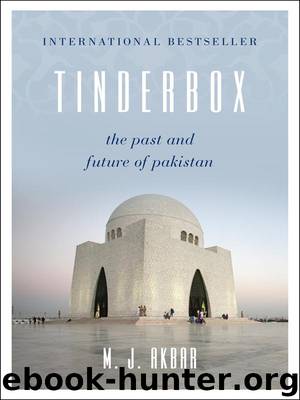Tinderbox by M.J. Akbar

Author:M.J. Akbar
Language: eng
Format: mobi, epub
Publisher: HarperCollins
Published: 2012-02-20T21:00:00+00:00
9
Breaking Point
There were five ‘swivel’ moments in Congress–Muslim relations before the formation of Pakistan. The pact negotiated by Jinnah in 1916, in which the Congress accepted separate electorates, was widely described as the basis on which Hindus and Muslims could unite against the British. The second moment, Gandhi’s Khilafat struggle, promised liberation but ended in despair. Jinnah crafted the third opportunity, in 1927 and 1928, when an all-party effort was made to create a Constitution for India by Indians; he failed to bridge the League–Congress gap. In 1937, the two parties could have cemented an electoral understanding with a post-election coalition in the United Provinces, but an ascendant Congress underestimated the potential of a depressed Muslim League. The fifth, and most tantalizing, chance appeared at the very last minute, in 1946, when the Congress and the League accepted the British Cabinet Mission Plan to retain a united India, but the Congress, fearful of Balkanization, reversed its decision. After this, their separate paths became irreversible.
Given that Muslim confidence in Gandhi had waned visibly by 1930, so much so that even a genuine believer like M.A. Ansari advised him to postpone his Salt Satyagraha until he could be sure of Muslim support, it wasn’t surprising that the British treated Congress as a largely Hindu party during the three Round Table Conferences convened in 1930 and 1932. These conferences, designed to formulate the next stage of the evolving political structure of the Raj, were held between 12 November and 19 January 1931, 7 September and 1 December 1931, and 17 November and 24 December 1932.
On 12 November 1930, George V, standing next to his throne in the Royal Gallery of the House of Lords, with Prime Minister Ramsay MacDonald and prime ministers of dominions in the audience, addressed fifty-eight delegates from British India and sixteen from the princely states. Gandhi was not there; he was still in jail.1 Notables like Jinnah, V.S. Srinivasa Sastri and Sir Tej Bahadur Sapru, princes and officials, had been selected to represent India.
Jinnah, as de facto leader of sixteen Muslim delegates, was given the floor after Sastri. He did not send the authorities an advance copy of his speech, as protocol required.2 Jinnah made a simple and sharp point: too many British sovereigns and prime ministers had offered India self-government but none had given it.
On 20 November, Jinnah argued that there were four interested parties: the British, princes, Hindus and Muslims. He wanted dominion status with satisfactory guarantees for Muslims: separate electorates, and insurance that the ‘Muslim’ status of Bengal and Punjab would be protected by a plurality of Muslim seats in the respective legislatures. Hindu and Sikh groups rejected the idea.
It took some heavy lifting to persuade Gandhi to sit at the Second Round Table, but the viceroy, fellow-vegetarian Lord Irwin, proved to be a muscular negotiator during their famous series of talks between 17 February and 5 March 1931. Irwin called this dialogue the ‘most dramatic personal encounter between a viceroy and an Indian leader’. As
Download
This site does not store any files on its server. We only index and link to content provided by other sites. Please contact the content providers to delete copyright contents if any and email us, we'll remove relevant links or contents immediately.
| Central Asia | Southeast Asia |
| China | Hong Kong |
| India | Japan |
| Korea | Pakistan |
| Philippines | Russia |
The Sympathizer by Viet Thanh Nguyen(4306)
The Rape of Nanking by Iris Chang(4139)
World without end by Ken Follett(3431)
Ants Among Elephants by Sujatha Gidla(3417)
Blood and Sand by Alex Von Tunzelmann(3140)
Japanese Design by Patricia J. Graham(3110)
City of Djinns: a year in Delhi by William Dalrymple(2514)
The Queen of Nothing by Holly Black(2498)
Foreign Devils on the Silk Road: The Search for the Lost Treasures of Central Asia by Peter Hopkirk(2434)
India's Ancient Past by R.S. Sharma(2416)
Inglorious Empire by Shashi Tharoor(2396)
Tokyo by Rob Goss(2389)
In Order to Live: A North Korean Girl's Journey to Freedom by Yeonmi Park(2346)
India's biggest cover-up by Dhar Anuj(2318)
Tokyo Geek's Guide: Manga, Anime, Gaming, Cosplay, Toys, Idols & More - The Ultimate Guide to Japan's Otaku Culture by Simone Gianni(2315)
The Great Game: On Secret Service in High Asia by Peter Hopkirk(2305)
Goodbye Madame Butterfly(2203)
Batik by Rudolf Smend(2124)
Living Silence in Burma by Christina Fink(2038)
